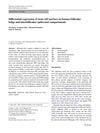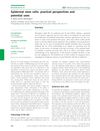The Contribution of Stem Cells to Epidermal and Hair Follicle Tumors in Dogs
January 2013
in “
Veterinary Dermatology
”
TLDR K15 is a reliable marker for studying stem cells in dog hair follicle tumors.
The study investigated the role of stem cells in canine epidermal and hair follicle tumors by examining the expression of keratin 15 (K15) and nestin in normal skin and 44 follicular tumors, as well as 30 squamous cell carcinomas. It was found that K15 was a reliable marker for studying stem cells in hair follicle tumors, while nestin was not optimal. K15 was expressed in the outer root sheath cells of the hair follicle's bulge region and scattered in the epidermis's basal layer. Trichoblastomas showed moderate to strong positivity for K15, while other tumors had varied expression. The study suggested that hair follicle stem cells in the bulge region might contribute to tumorigenesis in certain canine tumors, and the loss of K15 expression in squamous cell carcinomas could be significant in malignant transformation.




